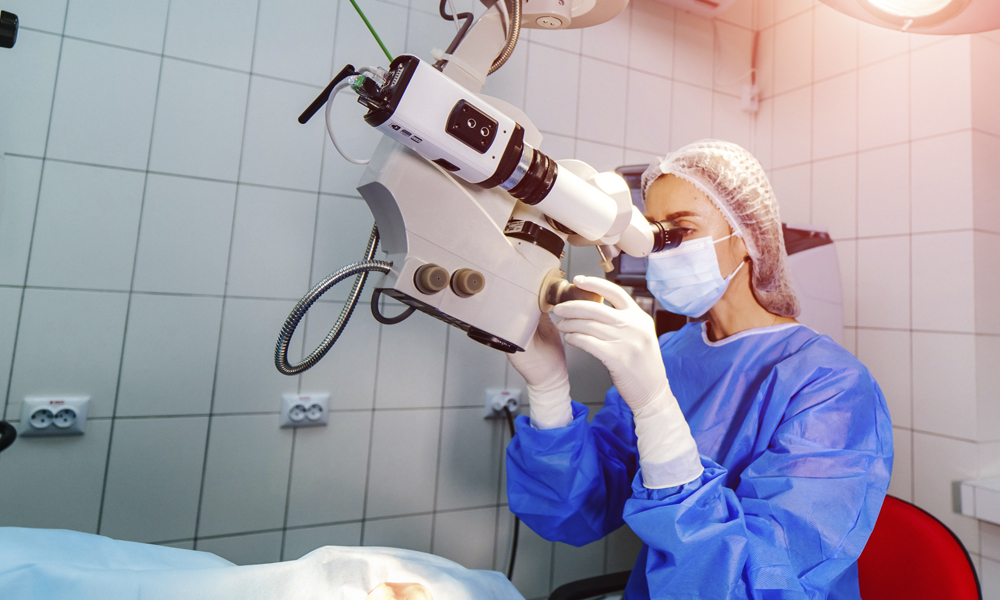-
 Toll Free No 9146-744-744
Toll Free No 9146-744-744 - Appointment
In simple language, a Cataract (मोतिबिंदू) (मोतियाबिंद) is termed a cloudy area formed in the lens of your eye very commonly found in today’s scenario. In fact, people aging 70 or older either have cataracts or have had surgery to get rid of cataracts.
Cataract surgery is a minimally invasive surgery that involves the removal of the cloudy eye lens and replacing it with an artificial lens.
Initially, you may not notice that you have a cataract, but over time, your vision becomes blurry, hazy, or less colorful, trouble reading or doing everyday activities. It not only occurs due to age but due to other reasons like eye injury or genetic factors. Unfortunately, cataracts cannot be treated through medications and surgery becomes the only effective treatment for cataracts. Well, if not treated on time, cataracts can cause permanent blindness as well.


If you discover any kind of vision problem, consult an Ophthalmologist without any delay. The doctor will check on your medical history and symptoms to narrow down your problem. If the doctor doubts having a cataract in one or both eyes, Doctor then might recommend the following tests that need to be done prior:
There are different types of Cataract Surgery.

The Intraocular lens (IOL) is used to restore the clarity of vision. There are several choices available to patients while making the choice of lens. The surgery prices vary with the choice of the lens made by patients.
These are monofocal which means these lenses are designed to correct the vision at one focal length. A patient can choose IOLs implants to correct for distance vision in both eyes, where they will most likely need glasses to read. While a patient can opt for an IOL to correct their vision for distance in one eye and an IOL that corrects their vision for near in the other eye.
This includes Presbyopia IOLs and Toric IOLs (The decision to use these lenses must be made by the patients)
PRESBYOPIA –CORRECTING INTRAOCULAR LENSES
These lenses are designed to correct for distance and near vision. The need for glasses is reduced to zero when the patient chooses these lenses for surgery.
These lenses are designed to correct distance vision and Astigmatism (irregularity in the curvature of the cornea). The patients who opt for this type of IOL implant will still need to wear reading glasses for all near activities like reading, writing, and computer tasks.
This is another option available to use during cataract surgery. It is an FDA-approved computer-guided laser treatment that is programmed by the surgeon. The potential risk or the complications involved can be better described by the doctor.
Most of the cataract surgeries are done by Phacoemulsification or Phaco. It is also called Small incision cataract surgery. In this surgery, a small incision is made on the side of the cornea. A tiny probe is inserted through this into the eye. This device emits ultrasound waves that soften and breaks up the lens so that it can be easily removed by suction.
In this type of surgery, a longer incision is made on the side of the cornea and the cloudy core of the lens is removed in one piece. The rest of the lens is removed by suction. After the removal of the natural lens, it is replaced by an artificial lens called an Intraocular lens (IOL). It is a clear, plastic lens that requires no care and it easily becomes a permanent part of your eye. The light is focused clearly by the IOL onto the retina which helps improve the vision. The patient will not feel the new lens after the surgery. In very rare cases, some people cannot have an IOL due to another eye disease or if in case any problem occurs during the surgery. For such patients, soft contact lenses or glasses with high magnification are suggested by the doctors which are also a safe option.
Cataract surgery costs 20k and above per eye depending on the types of lenses the patient chooses.
The cost varies based on:


There are minimal chances of recurrence after cataract surgery.
Yes, Diabetes patients can undergo cataract surgery. Please consult your doctor or ophthalmologist and mention your health condition prior to surgery.
The surgery takes a minimum of 15-30 minutes to complete.
Laser is considered more precise than manual surgery
You can take shower and bath as usual but with utmost precaution.
NOT as such but avoid eating spicy food.
Do not watch TV or make use of smartphones immediately after surgery, yes, it may harm the eye.
NO, there is no other treatment for cataracts.
The overall cost of the surgery varies, but the average cost is 20k and above per eye.
YES, cataract surgeries can be covered under the health insurance plans. For further assistance please consult our HospiOne Team.
OUR PROCESS IS EASY contact us for More information.
Copyright © 2023 hospione.com - All Rights Reserved | Developed by Digital Marketing StudioGenix LLP